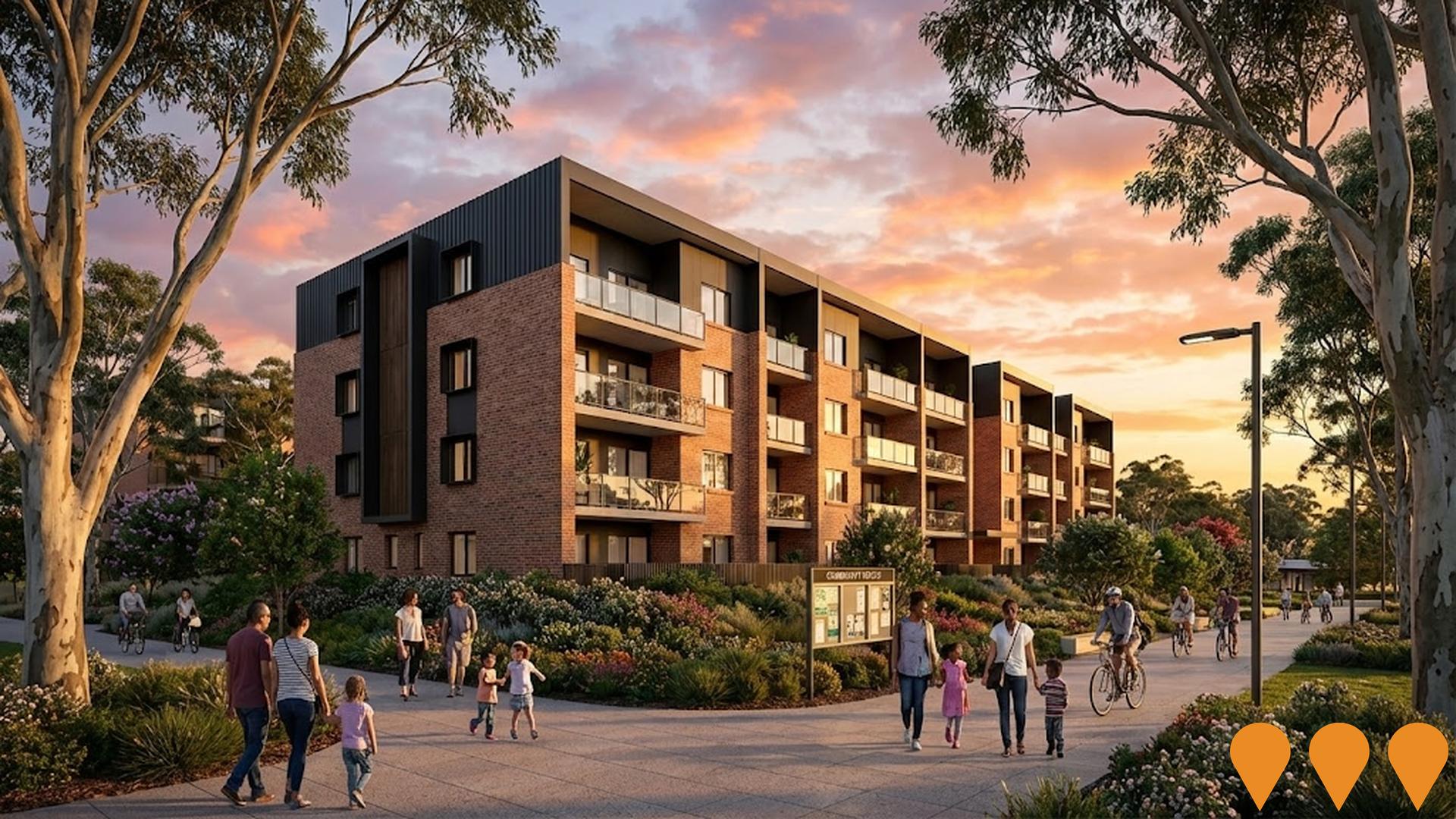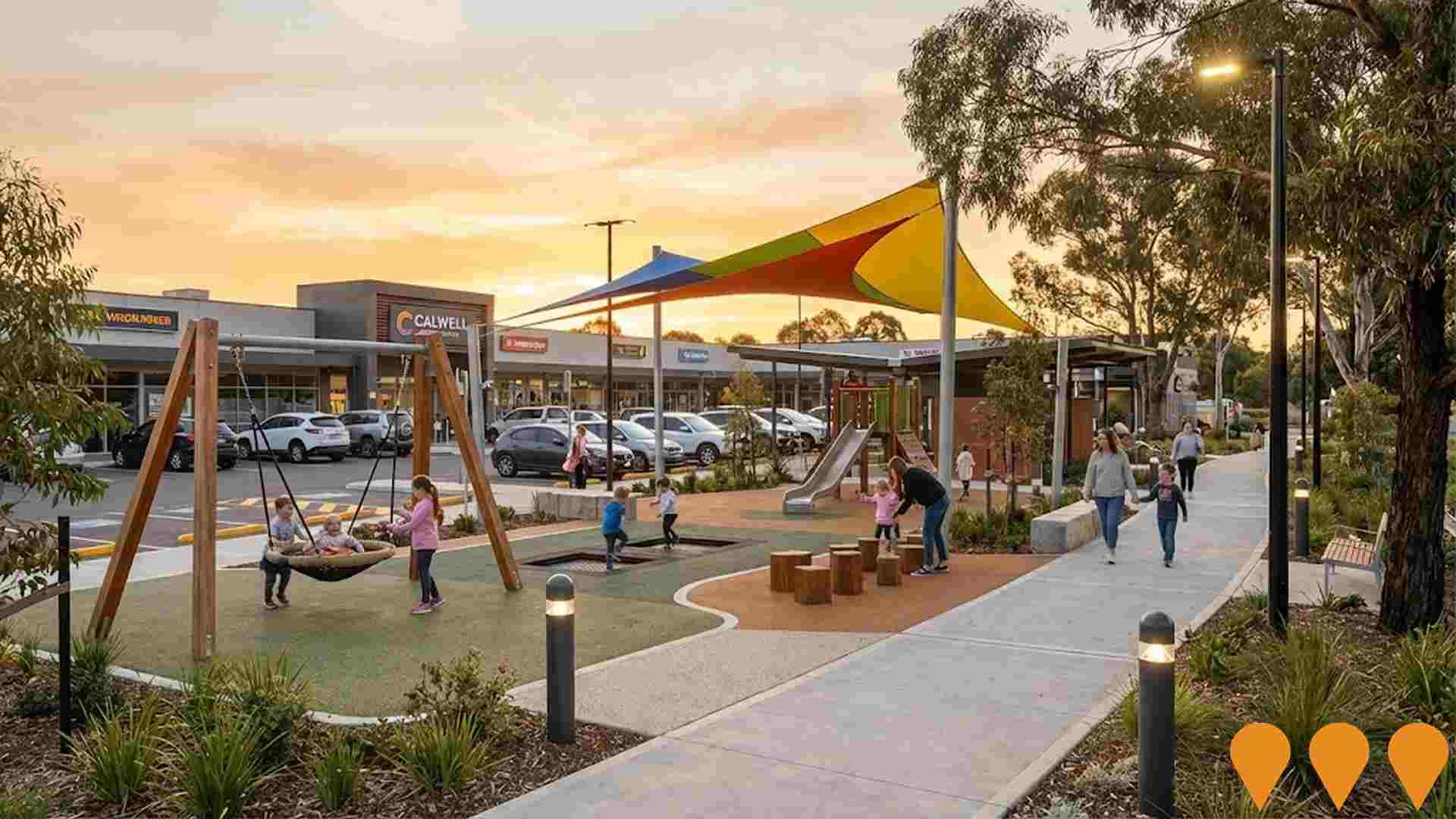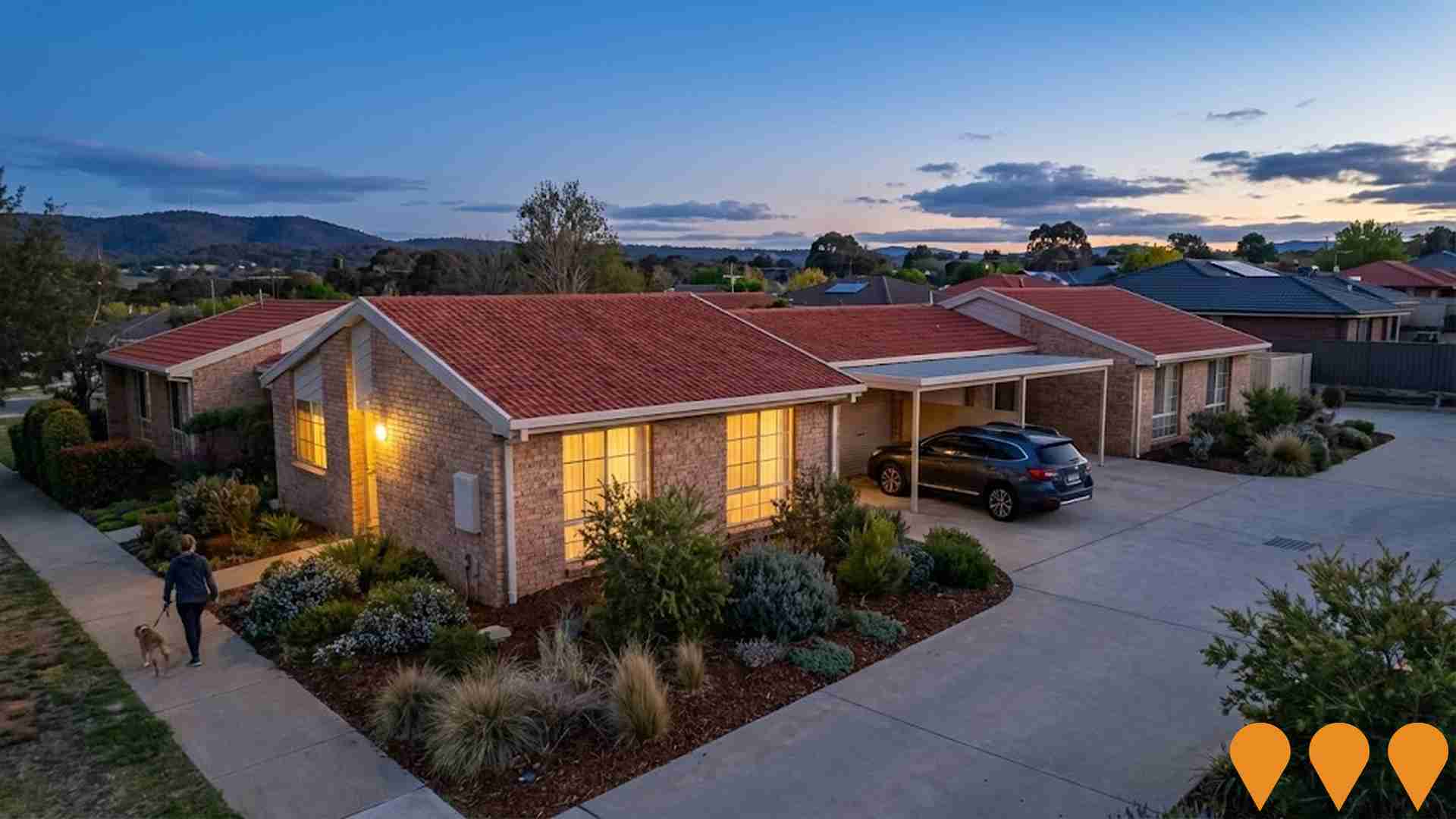Chart Color Schemes
est. as @ -- *
ABS ERP | -- people | --
2021 Census | -- people
Sales Activity
Curious about local property values? Filter the chart to assess the volume and appreciation (including resales) trends and regional comparisons, or scroll to the map below view this information at an individual property level.
Find a Recent Sale
Sales Detail
Population
Calwell has shown very soft population growth performance across periods assessed by AreaSearch
Calwell's population, as of November 2025, is approximately 5,557 people. This figure represents a decrease of 173 individuals (3.0%) compared to the 2021 Census, which recorded a population of 5,730 people. The change is inferred from ABS's estimated resident population of 5,555 as of June 2024 and an additional 30 validated new addresses since the Census date. This results in a population density ratio of 1,428 persons per square kilometer, exceeding the average across national locations assessed by AreaSearch. Overseas migration contributed approximately 56.0% of overall population gains during recent periods.
AreaSearch is adopting ABS/Geoscience Australia projections for each SA2 area, released in 2024 with a base year of 2022. For areas not covered by this data and years post-2032, age group growth rates from the ACT Government's SA2 area projections are used, also based on 2022. According to population projections, Calwell is expected to experience a population increase just below the national median statistical areas' average by 2041. The latest numbers suggest an increase of 278 persons by that year, representing a total gain of 4.9% over the 17-year period.
Frequently Asked Questions - Population
Development
The level of residential development activity in Calwell is very low in comparison to the average area assessed nationally by AreaSearch
Calwell has averaged approximately six new dwelling approvals annually over the past five financial years, with 34 homes approved between FY21 and FY25. No new dwellings have been approved in FY26 to date. The population decline during this period has maintained adequate housing supply relative to demand, resulting in a balanced market with good buyer choice.
The average construction cost of new dwellings is $166,000, below the regional average, indicating more affordable housing options for buyers. This financial year has seen $393,000 in commercial approvals, reflecting Calwell's residential nature. Compared to the Australian Capital Territory, Calwell has roughly half the rate of new dwelling approvals per person and ranks among the 6th percentile nationally, offering limited buyer choices and supporting demand for existing properties. This is below the national average, suggesting maturity and possible planning constraints in the area. Current development consists of 14.0% detached dwellings and 86.0% townhouses or apartments, a significant shift from the current housing pattern of 87.0% houses, indicating diminishing developable land availability and responding to evolving lifestyle preferences and affordability needs.
Future projections estimate Calwell's population to increase by 273 residents by 2041. If current construction levels continue, housing supply may lag behind population growth, potentially intensifying buyer competition and supporting price growth.
Frequently Asked Questions - Development
Infrastructure
Calwell has emerging levels of nearby infrastructure activity, ranking in the 32ndth percentile nationally
Changes in local infrastructure significantly affect an area's performance. AreaSearch has identified seven projects likely to impact the region. Notable ones include Banks Gateway Estate, Calwell Group Centre improvements, Calwell Retirement Living Precinct, and Calwell Public Housing Development. The following list details those most relevant.
Professional plan users can use the search below to filter and access additional projects.
INFRASTRUCTURE SEARCH
 Denotes AI-based impression for illustrative purposes only, not to be taken as definitive under any circumstances. Please follow links and conduct other investigations from the project's source for actual imagery. Developers and project owners wishing us to use original imagery please Contact Us and we will do so.
Denotes AI-based impression for illustrative purposes only, not to be taken as definitive under any circumstances. Please follow links and conduct other investigations from the project's source for actual imagery. Developers and project owners wishing us to use original imagery please Contact Us and we will do so.
Frequently Asked Questions - Infrastructure
Canberra Light Rail Stage 4 - Woden to Tuggeranong
Proposed extension of Canberra's light rail network from Woden Town Centre south to Tuggeranong Town Centre via Mawson and the Athllon Drive corridor. This future stage aims to complete the north-south radial mass transit spine, connecting major residential, employment and activity centres while supporting bus, cycling, walking and private vehicle integration.
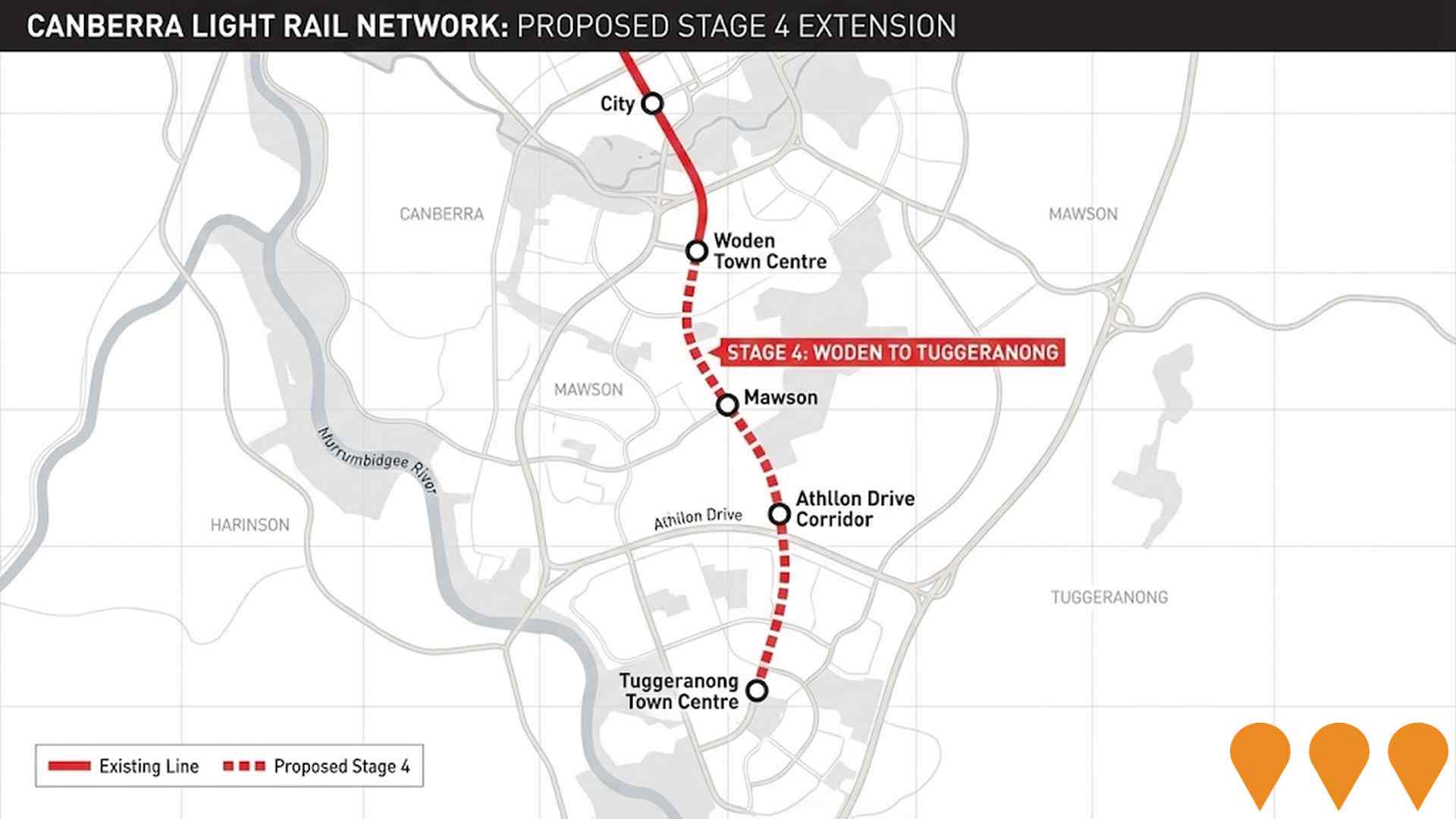
Enhanced bus and light rail corridors (Belconnen & Queanbeyan to Central Canberra)
ACT is progressing an integrated program to enhance high-frequency bus and future light rail corridors that link Belconnen and Queanbeyan with central Canberra. Light Rail Stage 2A (City to Commonwealth Park) commenced construction in early 2025 with services targeted from 2028, while planning and approvals continue for Stage 2B to Woden. The ACT Government has acknowledged and is planning upgrades for the Belconnen-to-City bus corridor as groundwork for a future east-west light rail Stage 3, and is coordinating cross-border public transport initiatives with NSW through the Queanbeyan Region Integrated Transport Plan and the ACT-NSW MoU for Regional Collaboration.
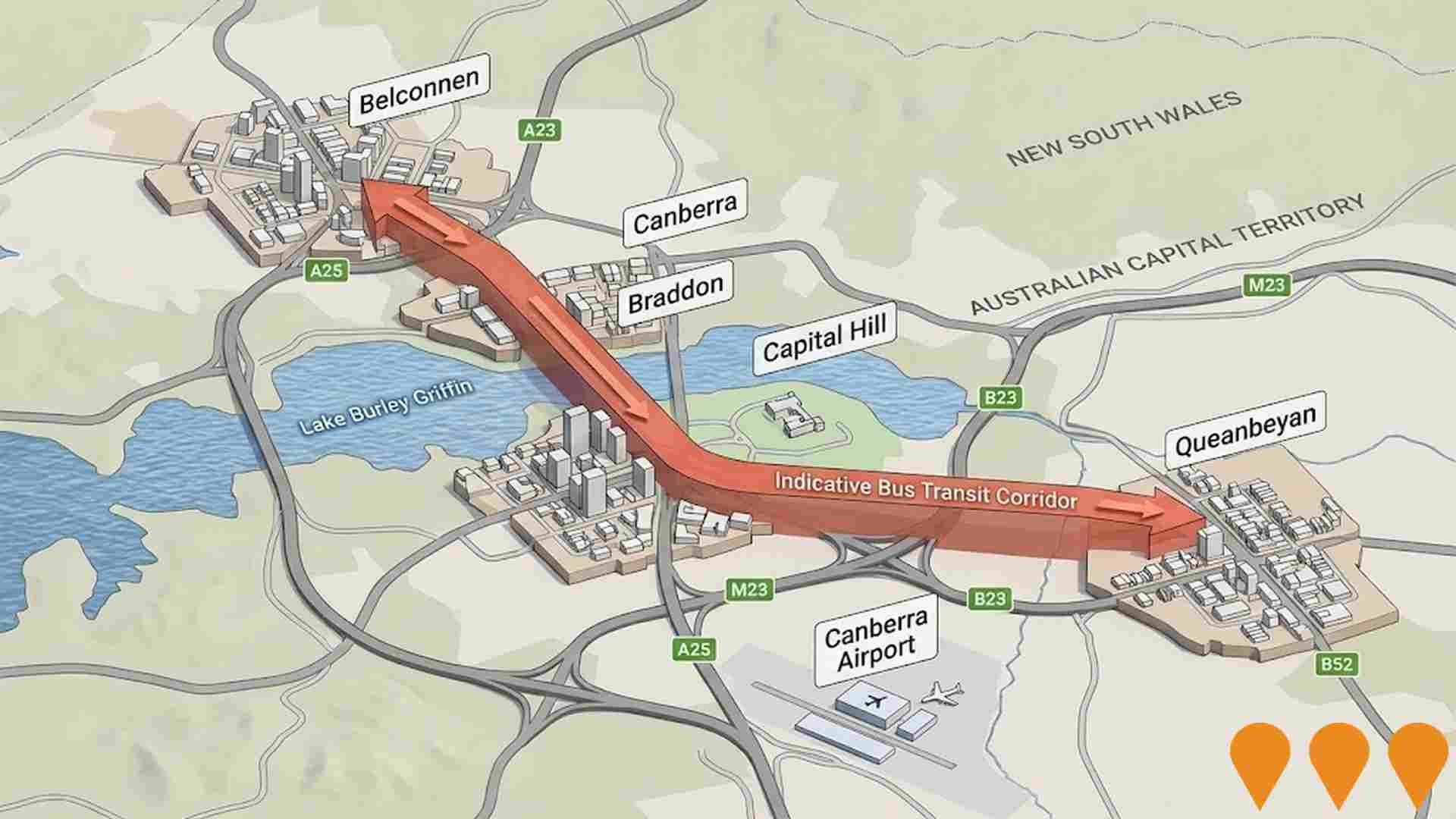
HumeLink
HumeLink is a new 500kV transmission line project connecting Wagga Wagga, Bannaby, and Maragle, spanning approximately 365 km. It includes new or upgraded infrastructure at four locations and aims to enhance the reliability and sustainability of the national electricity grid by increasing the integration of renewable energy sources such as wind and solar.
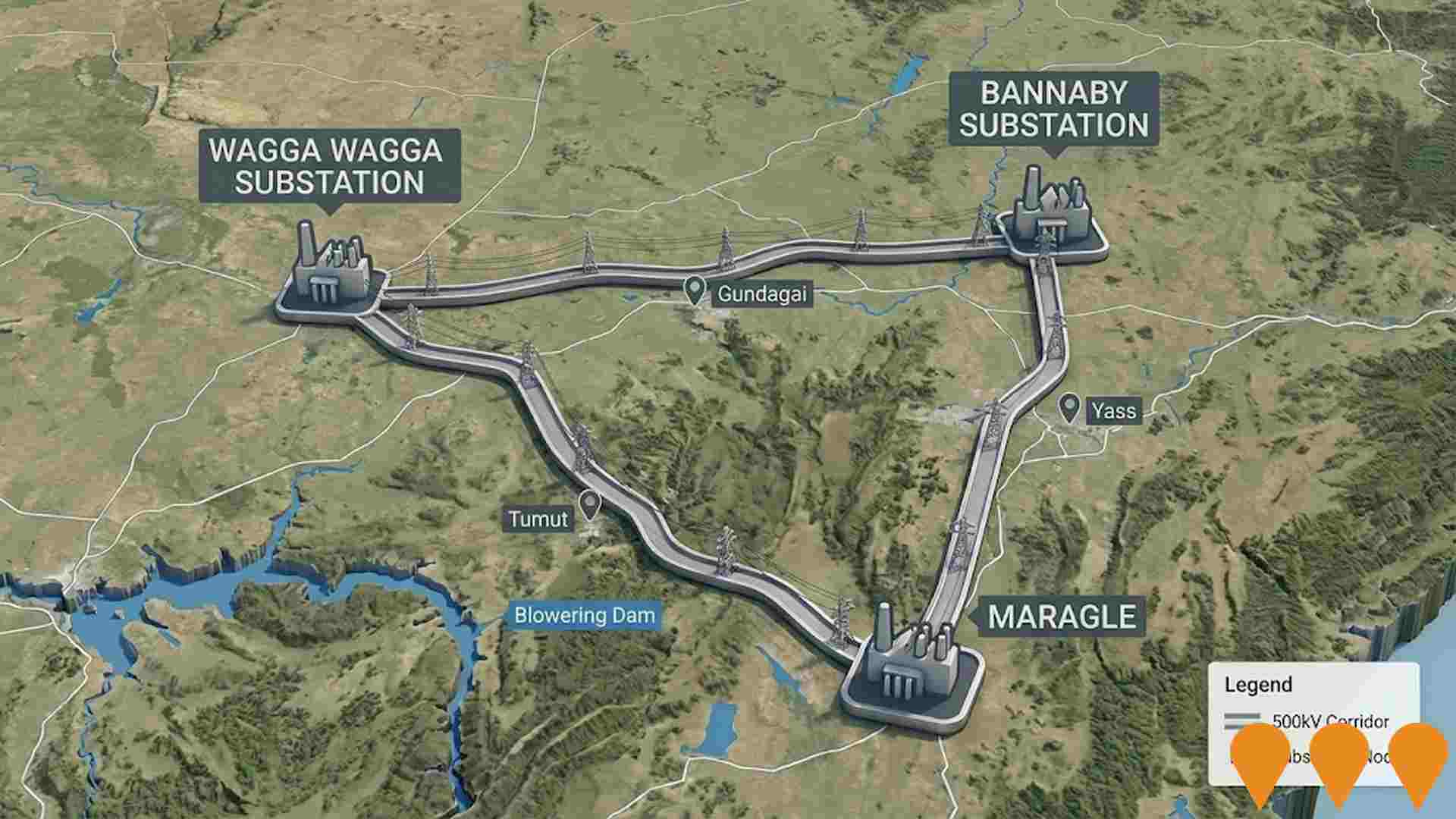
Queanbeyan Regional Integrated Transport Plan
Comprehensive transport planning initiative with 64 key actions for next 10 years. Addresses road safety, active transport connectivity, public transport availability, and future transport needs. Improved connections between Queanbeyan and ACT.
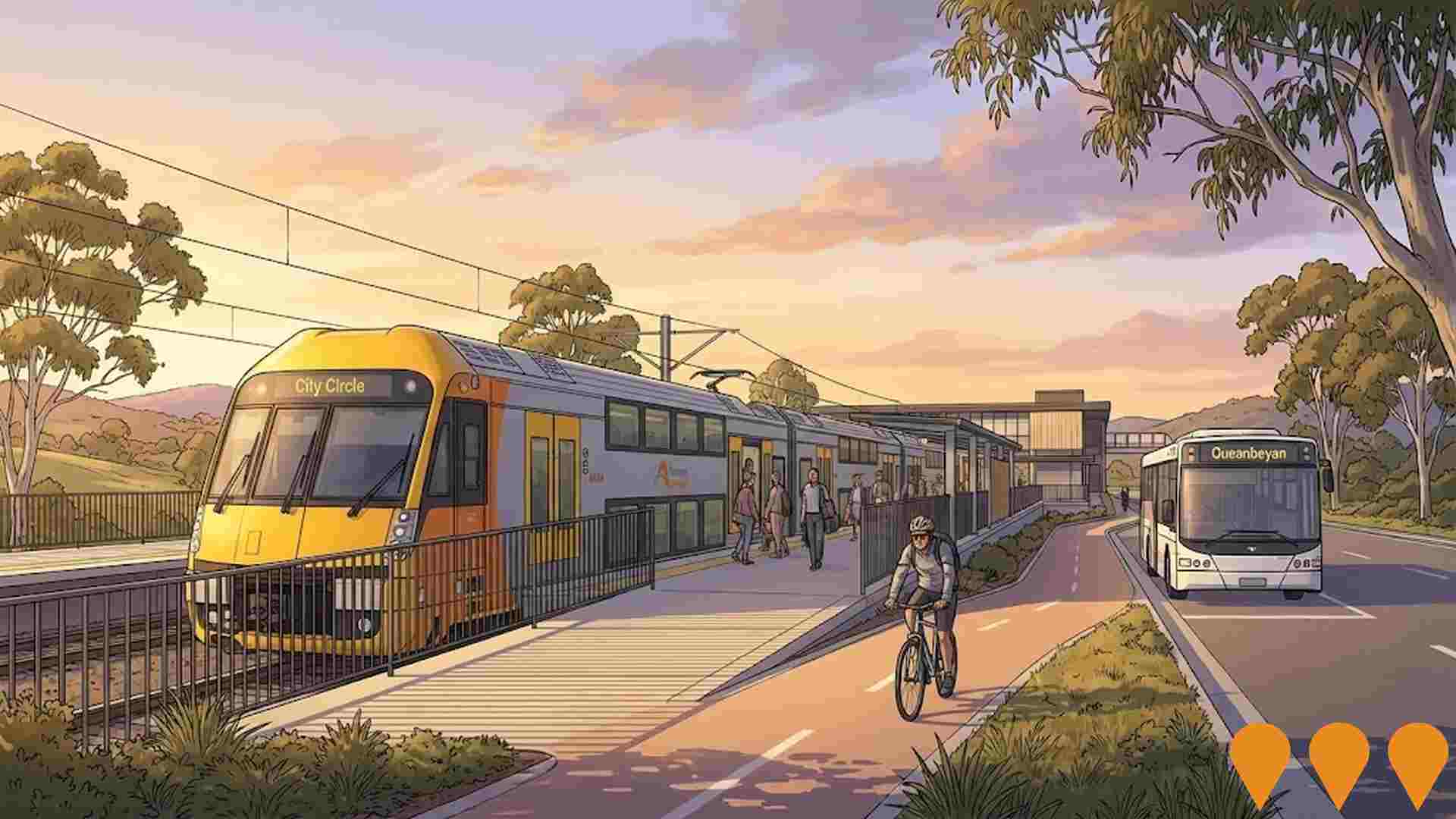
Big Canberra Battery (Williamsdale BESS)
A 250 MW / 500 MWh battery energy storage system at Williamsdale in southern Canberra, delivered by Eku Energy as Stream 1 of the ACT Government's Big Canberra Battery. Construction commenced in November 2024 with partners CPP and Tesla supplying Megapack systems. The asset will connect to Evoenergy's 132 kV network near the Williamsdale substation to provide two hours of dispatchable power, grid services and reliability for the ACT. Target operations in 2026.
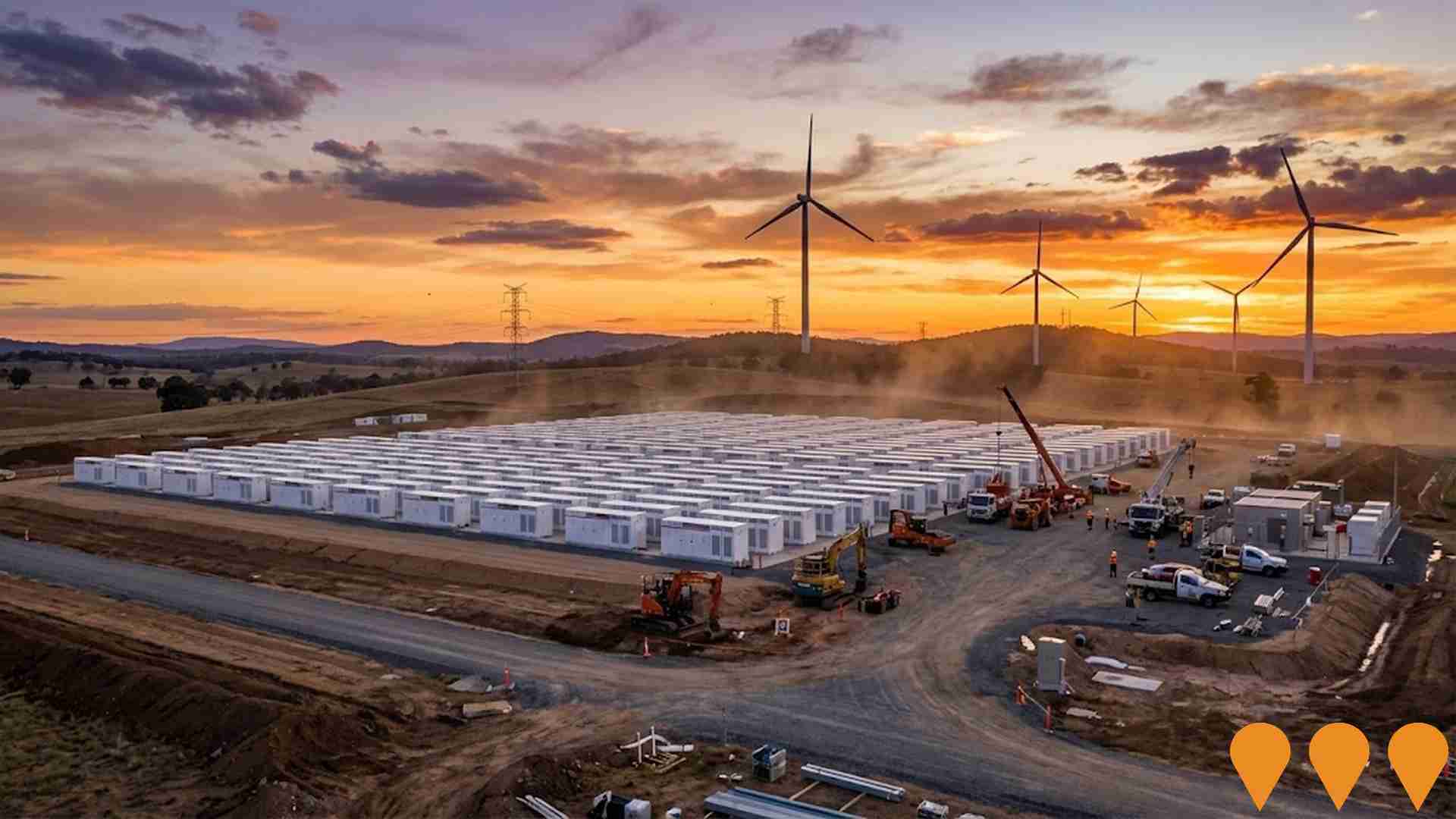
Lanyon Marketplace Improvements
Public space improvements completed in late 2023 at Lanyon Marketplace in Conder. The project, led by the ACT Government, included new seating and landscaping, improved pedestrian access (paths, pram ramps, safe crossings), a new raised intersection at Balcombe and Sidney Nolan Streets, and additional parking spaces on Sidney Nolan Street. The original record's mention of new Coles/Aldi/specialty stores appears to refer to an expected private sector expansion/refurbishment or is based on speculation, as the public works completed focused on the community space and access, with the Marketplace being anchored by Woolworths and 18 specialty shops. There is an ALDI store located at 9 Sidney Nolan Street nearby.

EV Fast Charging Infrastructure - Calwell (Calwell Shopping Centre)
Public DC fast EV charging delivered at Calwell Shopping Centre and operated by Evie Networks, supported by ACT Government grants and ARENA funding to expand Canberra's charging network.
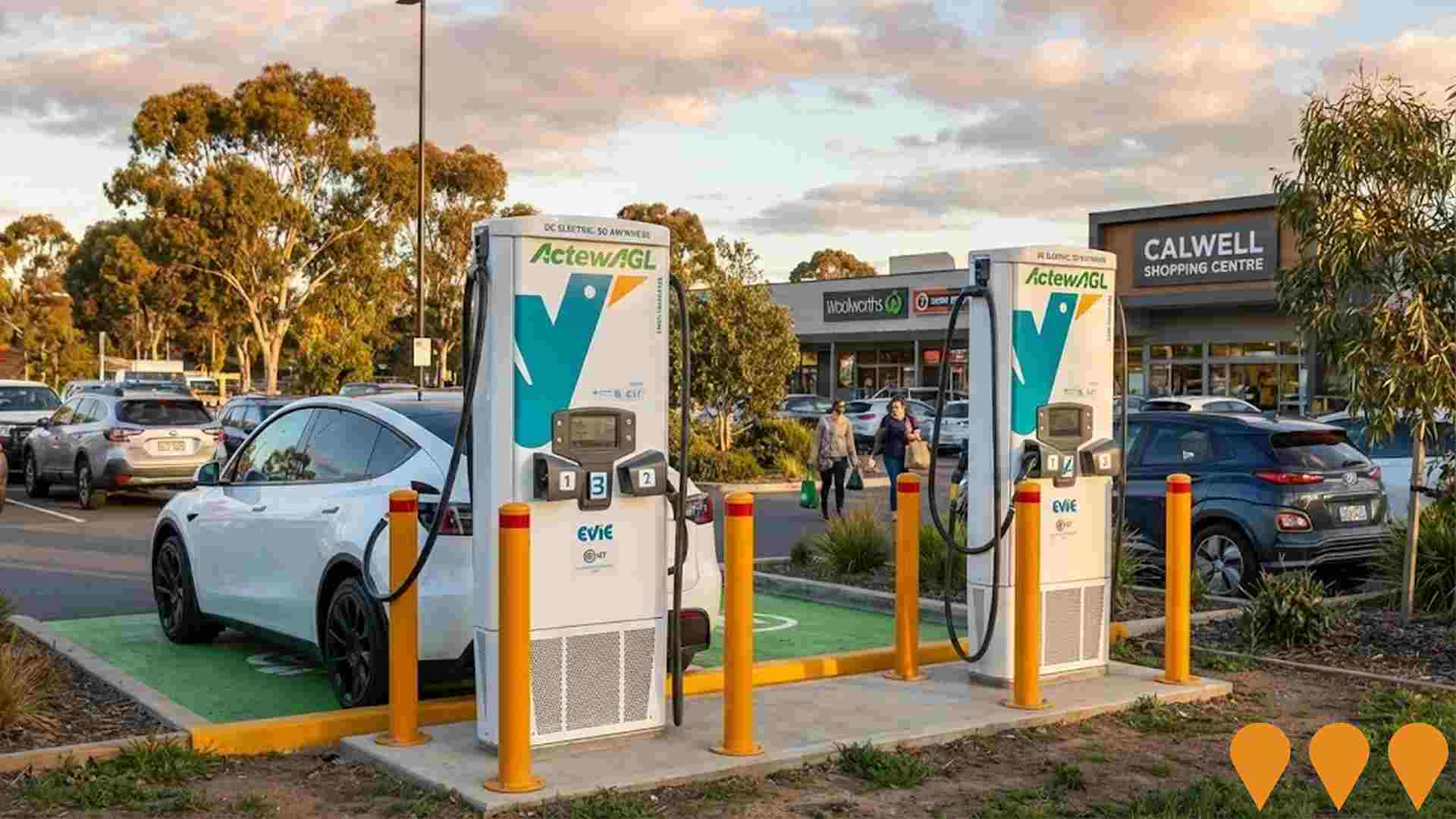
Calwell Public Housing Development
30 new public housing townhouses (2 and 3 bedroom) built to Class C Adaptable standards. Features evaporative heating/cooling, 6-star energy rating hot water systems, double-glazed windows, and sustainable design.
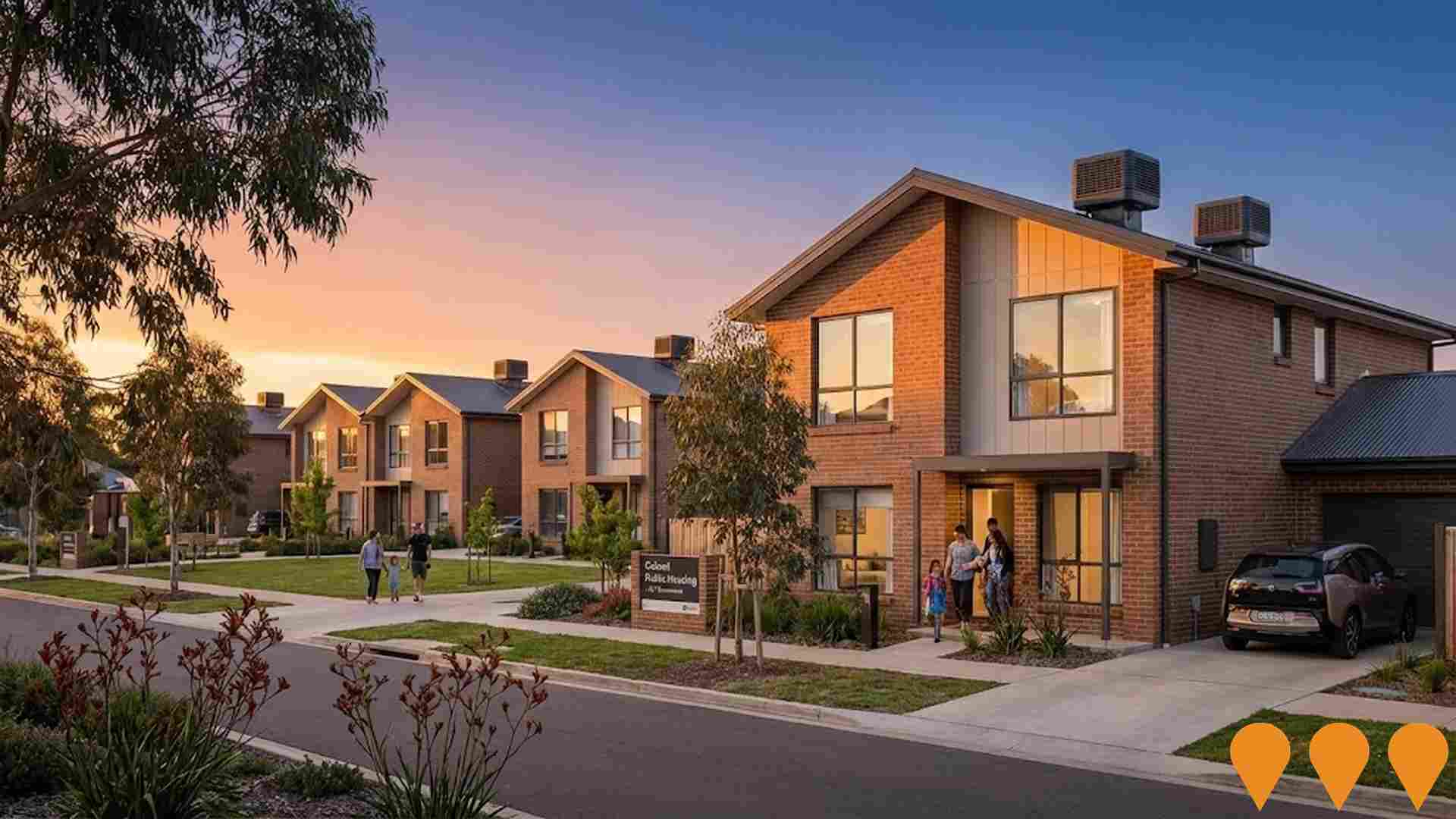
Employment
Employment performance in Calwell has been broadly consistent with national averages
Calwell has a well-educated workforce with notable representation in essential services sectors. The unemployment rate is 3.5%, with an estimated employment growth of 1.0% over the past year as of June 2025.
There are 3,255 residents employed, matching the Australian Capital Territory's (ACT) unemployment rate of 3.4%. Workforce participation is similar to ACT's 69.6%. Employment is concentrated in public administration & safety, health care & social assistance, and construction, with a particularly notable concentration in construction at 1.6 times the regional average. Professional & technical services have limited presence, with 7.9% employment compared to the regional average of 11.1%.
The area appears to offer limited local employment opportunities based on Census data. Over the 12 months to June 2025, employment increased by 1.0%, while labour force grew by 1.6%, causing the unemployment rate to rise by 0.6 percentage points. In contrast, ACT saw employment rise by 1.9% and unemployment fall by 0.3 percentage points. Jobs and Skills Australia's national employment forecasts from May 2025 suggest that Calwell's employment may increase by approximately 6.4% over five years and 13.1% over ten years, based on industry-specific projections applied to the local employment mix.
Frequently Asked Questions - Employment
Income
The economic profile demonstrates exceptional strength, placing the area among the top 10% nationally based on comprehensive AreaSearch income analysis
Calwell's median income among taxpayers was $70,379 in financial year 2022. The average income stood at $78,000 during the same period. These figures compare to the Australian Capital Territory's median and average incomes of $68,678 and $83,634 respectively. By September 2025, based on a Wage Price Index growth of 13.6%, estimated incomes would be approximately $79,951 (median) and $88,608 (average). Census data shows household, family, and personal incomes in Calwell rank highly nationally, between the 90th and 91st percentiles. The earnings profile indicates that 37.0% of residents (2,056 people) fall into the $1,500 - $2,999 weekly income bracket. Notably, 39.5% earn above $3,000 weekly. After housing costs, residents retain 87.0% of their income. The area's SEIFA income ranking places it in the 7th decile.
Frequently Asked Questions - Income
Housing
Calwell is characterized by a predominantly suburban housing profile, with ownership patterns similar to the broader region
In Calwell, as per the latest Census, 86.8% of dwellings were houses, with the remaining 13.2% being semi-detached, apartments, or other types. In comparison, Australian Capital Territory had 79.6% houses and 20.4% other dwellings. Home ownership in Calwell was 30.2%, similar to the ACT's rate, with mortgaged dwellings at 54.6% and rented ones at 15.2%. The median monthly mortgage repayment was $2,000, aligning with the ACT average. The median weekly rent was $448, compared to the ACT's $425. Nationally, Calwell's mortgage repayments exceeded the Australian average of $1,863, while rents were substantially higher than the national figure of $375.
Frequently Asked Questions - Housing
Household Composition
Calwell features high concentrations of family households, with a higher-than-average median household size
Family households constitute 78.1% of all households, including 38.5% couples with children, 26.2% couples without children, and 12.2% single parent families. Non-family households comprise the remaining 21.9%, with lone person households at 19.1% and group households making up 2.5%. The median household size is 2.7 people, which is larger than the Australian Capital Territory average of 2.6.
Frequently Asked Questions - Households
Local Schools & Education
The educational profile of Calwell exceeds national averages, with above-average qualification levels and academic performance metrics
The area's university qualification rate is 29.1%, significantly lower than the SA4 region average of 46.8%. Bachelor degrees are most common at 19.2%, followed by postgraduate qualifications (6.2%) and graduate diplomas (3.7%). Vocational credentials are prevalent, with 36.0% of residents aged 15+ holding them - advanced diplomas at 12.9% and certificates at 23.1%. Educational participation is high, with 28.7% currently enrolled in formal education: 10.2% in primary, 7.7% in secondary, and 4.2% in tertiary education.
Calwell's three schools have a combined enrollment of 1,060 students, serving typical Australian school conditions (ICSEA: 1013) with balanced educational opportunities. Education provision is balanced, with two primary and one secondary school serving distinct age groups. School capacity exceeds residential needs at 19.1 places per 100 residents compared to the regional average of 14.9, indicating the area serves as an educational center for the broader region.
Frequently Asked Questions - Education
Schools Detail
Nearby Services & Amenities
Transport
Transport servicing is good compared to other areas nationally based on assessment of service frequency, route connectivity and accessibility
The analysis of public transport in Calwell shows that there are currently 33 active transport stops operating. These stops serve a mix of bus routes, with a total of 9 individual routes providing service to the area. The combined weekly passenger trips across these routes amount to 1,597.
Residents have excellent accessibility to transport, with an average distance of 199 meters to the nearest stop. On average, there are 228 trips per day across all routes, which equates to approximately 48 weekly trips per individual stop.
Frequently Asked Questions - Transport
Transport Stops Detail
Health
Health outcomes in Calwell are marginally below the national average with common health conditions somewhat prevalent across both younger and older age cohorts
Calwell shows below-average health outcomes, with common conditions prevalent across both younger and older age groups.
Private health cover is exceptionally high at approximately 59% of the total population (3,267 people). The most common medical conditions are mental health issues affecting 9.4% of residents and asthma impacting 9.0%. A total of 66.9% of residents declared themselves completely clear of medical ailments, compared to 66.1% across the Australian Capital Territory. As of 2021, 15.9% of residents are aged 65 and over (882 people), lower than the 17.6% in the Australian Capital Territory. Health outcomes among seniors present some challenges, broadly in line with the general population's health profile.
Frequently Asked Questions - Health
Cultural Diversity
The level of cultural diversity witnessed in Calwell was found to be above average when compared nationally for a number of language and cultural background related metrics
Calwell's population shows above-average cultural diversity, with 19.1% born overseas and 14.0% speaking a language other than English at home. Christianity is the dominant religion in Calwell, accounting for 49.1%. Islam's representation is slightly higher than the Australian Capital Territory average, at 2.1% compared to 2.4%.
The top three ancestry groups are Australian (27.8%), English (26.4%), and Other (8.9%). Notably, Spanish (1.1%) Hungarian (0.4%), and Serbian (0.5%) ethnicities are more prevalent in Calwell than regionally.
Frequently Asked Questions - Diversity
Age
Calwell's population is slightly younger than the national pattern
Calwell's median age in 2021 was 37 years, slightly older than the Australian Capital Territory's 35 but aligned with the national average of 38 years. The 55-64 age group constituted 13.6%, higher than the Australian Capital Territory figure, while the 25-34 cohort stood at 13.3%. Between 2021 and the present, the 65-74 age group has increased from 8.1% to 10.2%, and the 35-44 cohort has risen from 12.8% to 14.8%. Conversely, the 45-54 cohort has decreased from 13.2% to 11.9%. By 2041, population forecasts indicate significant demographic shifts in Calwell. The 75-84 age group is projected to rise substantially, increasing by 183 people (86%) from 215 to 399. Notably, the combined 65+ age groups will account for 80% of total population growth, reflecting the area's aging demographic profile. In contrast, both 15-24 and 5-14 age groups are expected to decrease in numbers.


